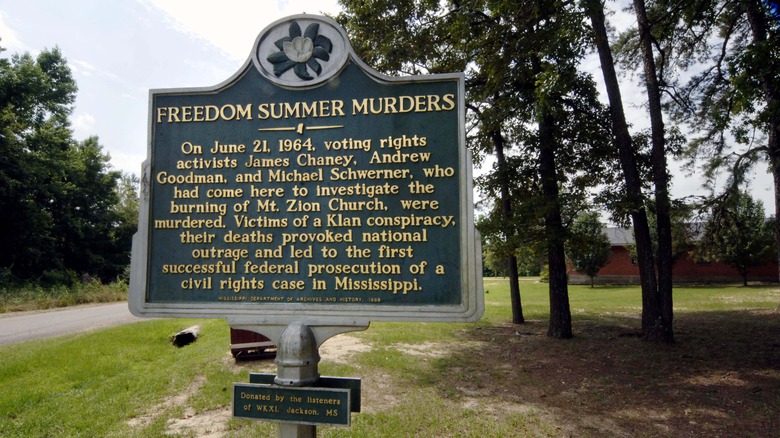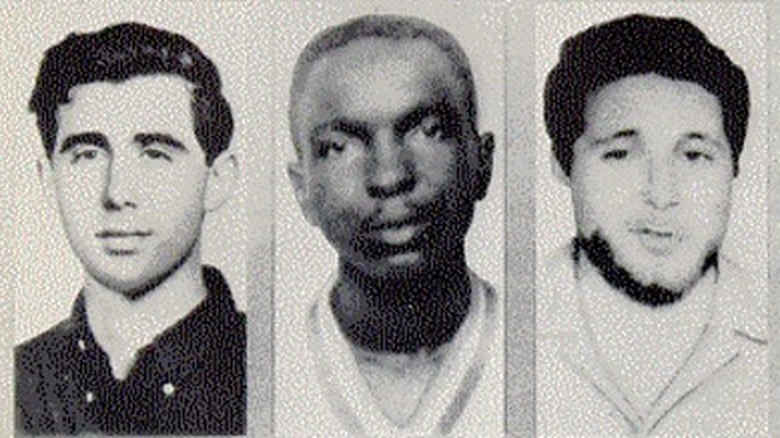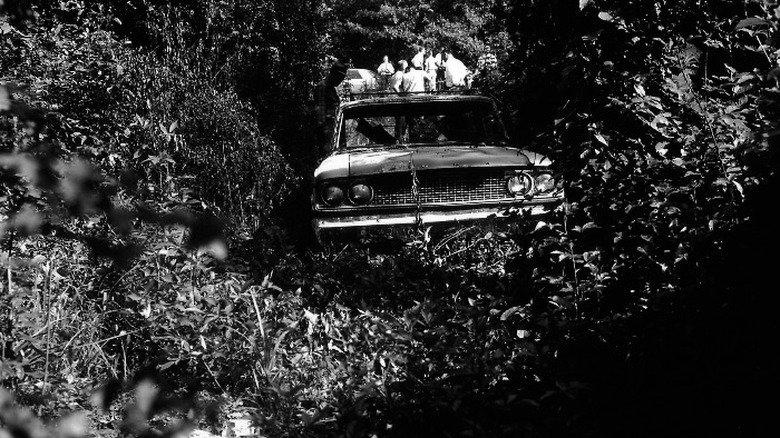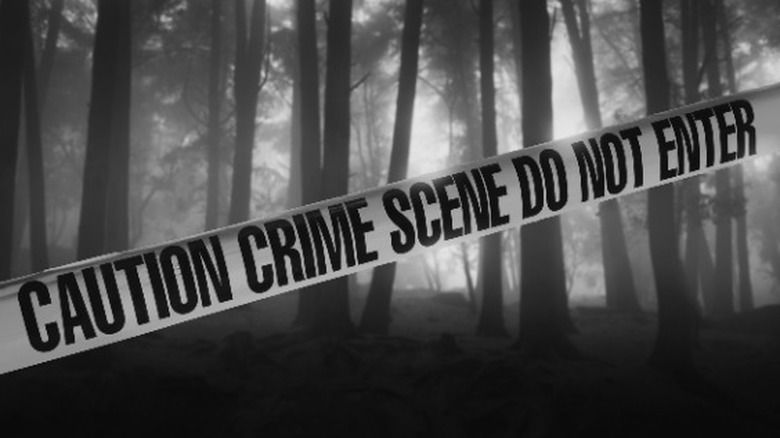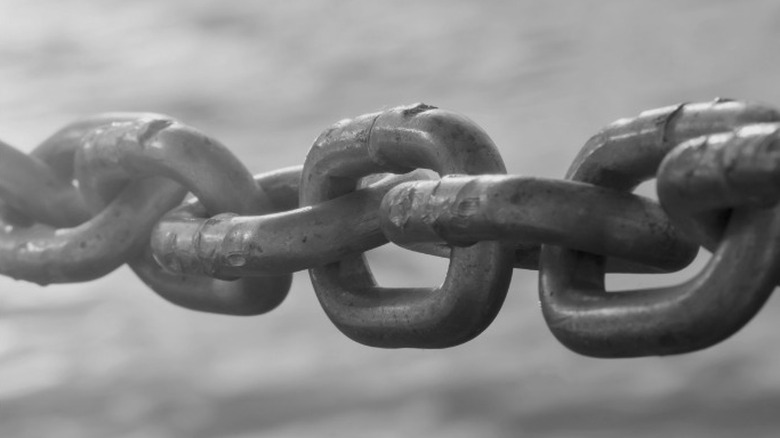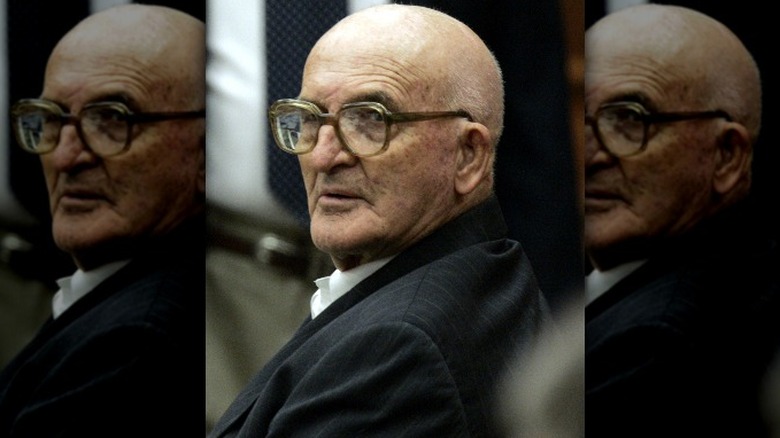Disturbing Details Found In The Mississippi Burning Murders Autopsy Reports
The June 13, 1963, assassination of Mississippi civil rights activist Medgar Evers brought national attention to the rising racial tensions throughout the state — which would eventually lead to the foundation of Mississippi's White Knights of the Ku Klux Klan, the burning of at least 20 Black churches, and the brutal deaths of three civil rights workers. One of the most contentious issues of the time was an effort to register black voters. As reported by Famous Trials, white supremacists, and the KKK in particular, increased pressure to intimidate Blacks and ultimately discourage them from pursuing increased civil rights. They also discouraged civil rights workers from leading the effort to increase and protect the rights of Blacks in Mississippi.
Amid the increasing tensions, James Chaney, Andrew Goodman, and Michael Schwerner became heavily involved in the civil rights movement. In addition to challenging segregation laws, Learning for Justice reports the three men were passionate about encouraging Blacks to register to vote. They also encouraged Black churches to host Freedom Schools, which, according to Civil Rights Teaching, provided a curriculum including arithmetic, history, reading, and writing so Blacks could progress beyond the traditional "sharecropper education" and therefore have more opportunities.
On May 25, 1964, Famous Trials reports Chaney and Schwerner spoke to the congregation at Neshoba County's Mt. Zion Methodist Church. In addition to discussing the Freedom School, they also urged the congregants to register to vote.
James Chaney, Andrew Goodman, and Michael Schwerner vanished under unusual circumstances
Fewer than three weeks later, on June 16, 1964, members of the KKK physically assaulted several leaders of the Mt. Zion Methodist Church. The following day, Famous Trials reports that the church was burned to the ground. On June 21, 1964, James Chaney, Andrew Goodman, and Michael Schwerner returned to the Mt. Zion Church to survey the damage and discuss the circumstances of the fire with the congregation. When the three civil rights workers left the scene of the fire, they were arrested. According to Ferris State University, they were arrested by Neshoba County Deputy Sheriff Cecil Price, who was reportedly a member of the KKK.
Chaney and Schwerner, in particular, had gained the attention of the local KKK for their work in the area and their speaking engagement at the Mt. Zion Church. Therefore, Price reportedly worked with the local KKK to formulate a plan that ultimately led to the brutal murders of the civil rights leaders. According to Ferris State University, Chaney, Goodman, and Schwerner were arrested on suspicion of arson in connection with the Mt. Zion Church fire. However, Price ordered the men to be released at around 10:00 p.m. that same evening. As they were on their way out of town, the civil rights leaders were chased down by members of the KKK, including Sheriff Price. They were then taken to a remote location where they were killed and ultimately buried in an earthen dam.
Michael Schwerner was killed by a bullet to the chest
Two days after James Chaney, Andrew Goodman, and Michael Schwerner seemingly disappeared, the vehicle, which had been driven by Chaney, was found abandoned in a swamp. However, as reported by the Journal of Liberal Arts and Humanities, the bodies were not recovered until August 4, 1964.
At the time, the state of Mississippi did not allow suspicious deaths to be labeled as homicides until a coroner's jury made that determination. However, Mississippi did not have a state medical examiner in August 1964. Therefore, the preliminary autopsies were performed by Dr. William P. Featherston, who was not certified in forensic pathology. However, he was joined by five FBI agents and assisted by a Mississippi Highway Patrol photographer, a local dentist, and three doctors from the University of Mississippi Medical Center's Pathology department.
Schwerner's remains were the first to be examined by Featherston and his team. The Journal of Liberal Arts and Humanities reports that Schwerner, who was 24 years old, was found wearing blue jeans, boots, socks, and no shirt. A lighter was found in the pocket of his jeans. Featherston's team determined that Schwerner was killed by a bullet wound to the chest. As stated in the autopsy report, "The gun was jammed into Schwerner's fourth rib and fired." The bullet entered the chest along the fourth rib, ricocheted against another rib, and ultimately became lodged in the cavity of Schwerner's left lung — where it was found by Featherston and his team.
Andrew Goodman was also killed by a bullet to the chest
As reported by the Journal of Liberal Arts and Humanities, Dr. William P. Featherston concluded that Michael Schwerner's death was caused by the bullet wound. The second autopsy was performed on 20-year-old Andrew Goodman. According to the autopsy report, Goodman was wearing dark pants, blue socks, Oxford-style shoes, and no shirt. Upon examination, Featherston and his team determined that Goodman was also shot in the chest at short range.
Although the bullet also entered Goodman's body near the fourth rib, there was no evidence of deflection, and the bullet appeared to have traveled directly into the spinal region — where it was found by Featherston and his team. Featherston concluded that Goodman was killed by the bullet wound. As the marks on the bullets recovered from Schwerner and Goodman's bodies were identical, he also concluded that both men were shot with the same weapon.
The autopsies of Goodman and Schwerner were both fairly straightforward, and it was generally accepted that both men were shot upon their arrival at the remote location. However, as reported by Journal of Liberal Arts and Humanities, the initial autopsy conducted on James Chaney become a point of controversy. As stated in the autopsy, Chaney, who was 21 years old, was found wearing dark green pants and a T-shirt. Upon beginning to examine the body, Featherston immediately noted multiple fractures on the right and left arms.
James Chaney was beaten before he was shot
Unlike Andrew Goodman and Michael Schwerner, who were each shot one time, James Chaney was shot three times. As reported by the Journal of Liberal Arts and Humanities, the first bullet entered the upper abdomen and became lodged in Chaney's back. The second bullet was found in Chaney's abdominal wall, though it was unclear specifically where the bullet entered the body. A third bullet struck Chaney in the head and left a wound that was described as an "explosive type fracture," extending from the temple to the base of his skull.
Featherston concluded that Chaney was killed by a gunshot wound to the head. Although he acknowledged that Chaney had numerous fractures, he was unable to determine what specifically caused those fractures and whether any of the three men were beaten prior to being shot. According to the Journal of Liberal Arts and Humanities, Dr. David M. Spain, who was a renowned pathologist, was called to conduct a second, independent autopsy on Chaney. In stark contrast to Featherston's report, Spain said there were obvious signs that Chaney had been physically assaulted prior to his death. In addition to severe damage to his wrist bones, Spain noted the lower jaw was "completely shattered and split vertically." Spain ultimately concluded that Chaney's injuries "could only be the result of an extremely severe beating with either a blunt instrument or chain."
Eight men were ultimately convicted in the deaths of James Chaney, Andrew Goodman, and Michael Schwerner
As reported by the Journal of Liberal Arts and Humanities, Dr. William P. Featherston and Dr. David M. Spain maintained their initial conclusions about the fractures James Chaney sustained, and the advanced decomposition of the bodies made it difficult to prove whether Chaney was actually beaten. However, two eyewitnesses later testified that Chaney was physically assaulted before he was killed.
Ferris State University reports that authorities eventually identified 18 men who were involved in the brutal murders of James Chaney, Andrew Goodman, and Michael Schwerner. Mississippi state officials refused to file charges against any of the men, and, at the time, there was no federal statute for murder. Therefore, the men were indicted on federal charges of violating the three men's civil rights.
Seven of the original 18 defendants, including Deputy Cecil Price and KKK Imperial Wizard Sam Bowers, were found guilty and sentenced to a maximum of 10 years. The charges against one man were ultimately dismissed, seven others were acquitted, and three of the men were released, as the jury could not reach a consensus on the question of their guilt.
The seven men who were convicted in the Mississippi Burning trial were all released within six years of their incarceration. In 2005, Ferris State University reports that Edgar Ray Killen — who was accused of orchestrating the murders of Chaney, Goodman, and Schwerner — was charged and convicted of three counts of manslaughter. He was sentenced to 20 years in prison.
